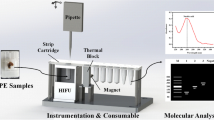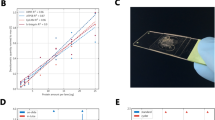Abstract
Based on the antigen retrieval principle, our previous study has demonstrated that heating archival formalin-fixed, paraffin-embedded (FFPE) tissues at a higher temperature and at higher pH value of the retrieval solution may achieve higher efficiency of extracted DNA, when compared to the traditional enzyme digestion method. Along this line of heat-induced retrieval, this further study is focused on development of a simpler and more effective heat-induced DNA retrieval technique by testing various retrieval solutions. Three major experiments using a high temperature heating method to extract DNA from FFPE human lymphoid and other tissue sections were performed to compare: (1) different concentrations of alkaline solution (NaOH or KOH, pH 11.5–12) versus Britton and Robinson type of buffer solution (BR buffer) of pH 12 that was the only retrieval solution tested in our previous study; (2) several chemical solutions (SDS, Tween 20, and GITC of various concentrations) versus BR buffer or alkaline solution; and (3) alkaline solution mixed with chemicals versus BR buffer or single alkaline solution. Efficiency of DNA extraction was evaluated by measuring yields using spectrophotometry, electrophoretic pattern, semiquantitation of tissue dissolution, PCR amplification, and kinetic thermocycling-PCR methods. Results showed that boiling tissue sections in 0.1 M NaOH or KOH or its complex retrieval solutions produced higher yields and better quality of DNA compared to BR buffer or chemical solutions alone. The conclusion was that boiling FFPE tissue sections in 0.1 M alkaline solution is a simpler and more effective heat-induced retrieval protocol for DNA extraction. Combination with some chemicals (detergents) may further significantly improve efficiency of the heat-induced retrieval technique.






Similar content being viewed by others
References
Auerbach C, Moutschen-Dahmen M, Moutschen J (1977) Genetic and cytogenetical effects of formaldehyde and related compounds. Mutat Res 39:317–362
Banerjee SK, Makdisi WF, Weston AP, Mitchell SM, Campbell DR (1995) Microwave-based DNA extraction from paraffin-embedded tissue for PCR amplification. Biotechniques 18:768–773
Birnboim HC, Doly J (1979) A rapid alkaline extraction procedure for screening recombinant plasmid DNA. Nucleic Acids Res 7:1513–1523
Dubeau L, Chandler LA, Gralow JR, Nichols PW, Jones PA (1986) Southern blot analysis of DNA extracted from formalin-fixed pathology specimens. Cancer Res 46:2964–2969
Fang S-G, Wan Q-H, Fujihara N (2002) Formalin removal from archival tissue by critical point drying. Biotechniques 33:604–611
Goelz SE, Hamilton SR, Vogelstein B (1985) Purification of DNA from formaldehyde-fixed and paraffin-embedded tissue. Biochem Biophys Res Commun 130:118–126
Higuchi R, Fockler C, Dollinger G, Watson R (1993) Kinetic PCR analysis: real-time monitoring of DNA amplification reactions. Biotechnology 11:1026–1030
Inadome Y, Noguchi M (2003) Selection of higher molecular weight genomic DNA for molecular diagnosis from formalin-fixed material. Diagn Mol Pathol 12:231–236
Klintschar M, Neuhuber F (2000) Evaluation of an alkaline lysis method for the extraction of DNA from whole blood and forensic stains for STR analysis. J Forensic Sci 45:669–673
Kulski JK, Pryce T (1996) Preparation of mycobacterial DNA from blood culture fluids by simple alkali wash and heat lysis method for PCR detection. J Clin Microbiol 34:1985–1991
Masuda N, Ohnishi T, Kawamoto S, Monden M, Okubo K (1999) Analysis of chemical modification of RNA from formalin-fixed samples and optimization of molecular biology applications for such samples. Nucleic Acids Res 27:4436–4443
McGhee JD, von Hippel PH (1977a) Formaldehyde as a probe of DNA structure. 3. Equilibrium denaturation of DNA and synthetic polynucleotides. Biochemistry 16:3267–3275
McGhee JD, von Hippel PH (1977b) Formaldehyde as a probe of DNA structure. 4. Mechanism of the initial reaction of formaldehyde with DNA. Biochemistry 16:3276–3293
Parodi S, Mulivor RA, Martin JT, Nicolini C, Sarma DS, Farber E (1975) Alkaline lysis of mammalian cells for sedimentation analysis of nuclear DNA. Conformation of released DNA as monitored by physical, electron microscopic and enzymological techniques. Biochim Biophys Acta 407:174–190
Rudbeck LD, Dissing J (1998) Rapid, simple alkaline extraction of human genomic DNA from whole blood, buccal epithelial cells, semen and forensic stains for PCR. Biotechniques 25:588–592
Sato Y, Sugie R, Tsuchiya B, Kameya T, Natori M, Mukai K (2001) Comparison of the DNA extraction methods for polymerase chain reaction amplification from formalin-fixed and paraffin-embedded tissues. Diagn Mol Pathol 10:265–271
Shi S-R, Cote RJ, Taylor CR (2001) Antigen retrieval immunohistochemistry and molecular morphology in the year 2001. Appl Immunohistochem Mol Morphol 9:107–116
Shi S-R, Cote RJ, Wu L, Liu C, Datar R, Shi Y, Liu D, Lim H, Taylor CR (2002) DNA extraction from archival formalin-fixed, paraffin-embedded tissue sections based on the antigen retrieval principle: heating under the influence of pH. J Histochem Cytochem 50:1005–1011
Thomas JCA, Doty P (1956) The mild acidic degradation of desoxyribose nucleic acid. J Am Chem Soc 78:1854–1860
Valsecchi E (1998) Tissue boiling: a short-cut in DNA extraction for large-scale population screenings. Mol Ecol 7:1243–1245
Wang H, Qi M, Cutler AJ (1993) A simple method of preparing plant samples for PCR. Nucleic Acids Res 21:4153–4154
Acknowledgements
This study is supported by NIH grants 1 R21 CA91249-01 and 1 R33 CA103455-01. We greatly appreciate Dr. Yan Shi’s valuable contribution in comments on this study and statistical analysis of results. We thank Ms Joanne Lim for her help in doing part of the technical work for DNA extraction from archival tissue sections, and literature collection, Mr. Stephen Beil for his kind help in preparing illustrations, and Lillian Young and Mo-Li Chen from USC/Translational Pathology Core Facility, Adult Tissue Arm (Los Angeles, CA, USA) for providing FFPE blocks.
Author information
Authors and Affiliations
Corresponding author
Rights and permissions
About this article
Cite this article
Shi, SR., Datar, R., Liu, C. et al. DNA extraction from archival formalin-fixed, paraffin-embedded tissues: heat-induced retrieval in alkaline solution. Histochem Cell Biol 122, 211–218 (2004). https://doi.org/10.1007/s00418-004-0693-x
Accepted:
Published:
Issue Date:
DOI: https://doi.org/10.1007/s00418-004-0693-x




